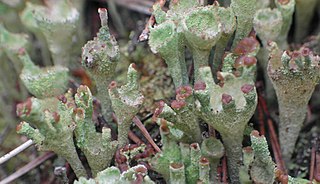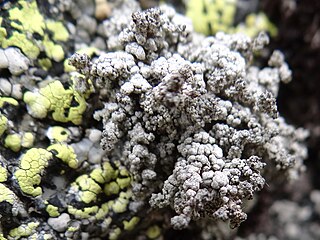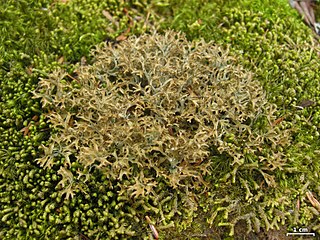
Cladonia rangiferina, also known as reindeer cup lichen, reindeer lichen or grey reindeer lichen, is a light-colored fruticose, cup lichen species in the family Cladoniaceae. It grows in both hot and cold climates in well-drained, open environments. Found primarily in areas of alpine tundra, it is extremely cold-hardy.

Lecanora polytropa, the granite-speck rim lichen, is a species of saxicolous (rock-dwelling), crustose lichen in the family Lecanoraceae. A small, inconspicuous species that grows in the cracks of rock surfaces, it has a cosmopolitan distribution and has been recorded on all continents, including Antarctica.

Cladonia carneola or the crowned cup lichen is a species of fruticose, cup lichen in the family Cladoniaceae. It was described as a new species by Swedish mycologist Elias Magnus Fries. Lichenicolous fungi that have been recorded growing on Cladonia carneola include Phaeopyxis punctum and Taeniolella beschiana.

Stereocaulon paschale is a species of lichen belonging to the family Stereocaulaceae.

Cladonia pyxidata or the pebbled cup lichen is a species of cup lichen in the family Cladoniaceae. It is host to the lichenicolous fungus Lichenoconium pyxidatae.

Cladonia uncialis is a species of fruticose, cup lichen in the family Cladoniaceae. It was first described as a new species by Swedish taxonomist Carl Linnaeus in 1753. It was transferred to the genus Cladonia by Friedrich Heinrich Wiggers in 1780. In North America, the lichen is colloquially known as the thorn Cladonia or the thorn cup lichen.

Stereocaulon alpinum is a species of fungus belonging to the family Stereocaulaceae. It is similar to Stereocaulon paschale but differs from it in containing cyanobacteria of the genus Nostoc while S. paschale contains cyanobacteria of the genus Stigonema, which have a darker colour than Nostoc.
Lichenopeltella uncialicola is a species of fungus belonging to the class Dothideomycetes. The species was discovered in Iceland in 2010 where it was found growing on Cladonia uncialis. Since then, it has been found on a different host species, Cladonia rangiferina, in North-Korea, Italy Austria, and Greenland.
Endococcus hafellneri is a species of lichenicolous (lichen-eating) fungus in the family Verrucariaceae. It is found in North Asia and the Russian Far East, Estonia, and Japan, where it grows on the lobes of the lichens Flavocetraria cucullata and Cetraria islandica.

Stereocaulon vesuvianum is a species of snow lichen belonging to the family Stereocaulaceae.

Stereocaulon saxatile is a species of snow lichen belonging to the family Stereocaulaceae.
Stereocaulon rivulorum is a species of snow lichen belonging to the family Stereocaulaceae.
Cercidospora stereocaulorum is a species of lichenicolous fungus in the genus Cercidospora but it has not been assigned to a family. It is known to parasitise lichens of the genus Stereocaulon.
Sphaerellothecium araneosum is a species of lichenicolous fungus in the family Phyllachoraceae.

Cladonia pocillum is a species of lichen in the family Cladoniaceae. Swedish botanist Erik Acharius first formally described the species in 1803 as Baeomyces pocillum, but Olivier Jules Richard transferred it to the genus Cladonia in 1877.
Polycoccum laursenii is a species of lichenicolous fungus in the family Polycoccaceae. It was first described as a new species in 2004 by Russian mycologist Mikhail Petrovich Zhurbenko. It is found in Alaska and in Russia.
Arthonia stereocaulina is a species of lichenicolous fungus in the family Arthoniaceae.
Endococcus nanellus is a species of lichenicolous fungus in the order Dothideales. It is known from Alaska, Canada, Greenland, Hawaii, Japan, Russia, South-Korea, and Kazakhstan.

Cetraria laevigata is a species of ground-dwelling, fruticose (bushy) lichen in the family Parmeliaceae. It was formally described as a new species by Russian lichenologist Kseniya Aleksandrovna Rassadina in 1943. In North America, it is commonly known as the striped Iceland lichen.
Carbonea aggregantula is a species of lichen belonging to the family Lecanoraceae.











